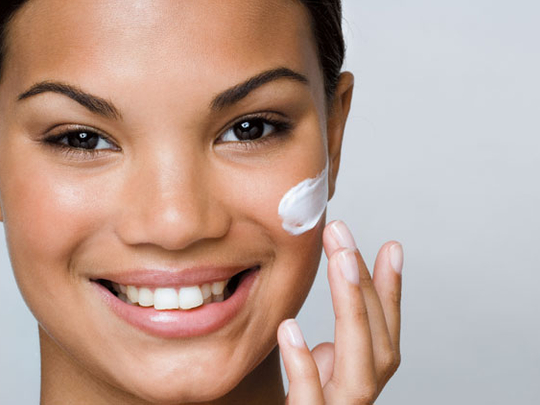
In a market flooded with various skincare creams, it's natural for a woman wanting a radiant and clear complexion to pale with confusion when it comes to choosing one that's right for her.
While one cream offers a breakthrough gel formulation, the other says it will provide overnight hydration through its time-release technology and yet another promises anti-ageing benefits along with light-reflecting properties for a flawless look. Are there any differences between these products or are they all the same?
Dr Maria Angelo-Khattar, managing director and founder of the Aesthetica Clinic, Dubai, and a member of the American Academy of Anti-Aging Medicine, demystifies the world of skin creams.
Every skin type, dry, oily or combination, has a skin cream that comes in a texture suited to it. Is this true?
Mostly. Moisturisers, for example, come in different textures - gels, lotions, creams and oils. These are meant to benefit different types of skin and user preferences. If a woman has normal skin, she should use a water-based moisturiser. These are light, airy and non-greasy formulations.
Moisturisers containing heavier formulations and oils work well on ageing or mature skin. They have a longer staying power as they don't dry out on skin easily. With oily skin, acne, pimples and breakouts are quite common. It is important therefore to cleanse regularly and keep skin hydrated with a light moisturiser.
For oily skin, a gel-based, non-comedogenic moisturiser works best. For sensitive skin (that reacts to pollutants, dust and the like, and gets red and blotchy as a result), a fragrance-free moisturiser is a must. Consult a skin expert before buying the cream as this type of skin is quick to react to products.
Let your dermatologist decide if your skin really needs the product you wish to buy. When using a product for sensitive skin, if there is a tingling sensation, it can be good news or bad. Good news because some creams containing Vitamin C can cause this effect but it is nothing to worry about. The sensation fades in a matter of minutes. However, if you notice your skin reacting really badly after using a product, discontinue its use and consult a skin expert immediately.
Some cream formulations have two kinds of textures for the same purpose, a cream base or a water-rich gel base. Do both give the same results?
Both creams give the same results. Women with oily skin can use the gel formulation while the thick, rich creams can be used on mature and dry skin.
How much cream should one use for every application?
Ideally, a dirham-size dollop is enough. Using more than this will clog the skin's pores.
Many day creams give skin a slightly greasy look. How does one ensure a shine-free face?
Dust your face lightly with mineral powder five minutes after applying the cream. After this, blot your face with a soft tissue to set the powder.
Can women with dry skin use mattifying moisturisers?
No. This will lead to more dryness. Women with dry skin should use oil-rich moisturisers while women with oily skin must choose mattifying moisturisers.
Do all creams for oily skin possess mattifying properties?
Not necessarily. But, yes most products for this skin type contain mattifying ingredients.
Just how much of a product can the skin absorb?
Skin creams can easily penetrate the skin up to the second and third layer. Some select anti-ageing products, claim they can reach up to the seventh layer but I would recommend you seek a dermatologist or skin aesthetician's help when choosing high-yield products for your skin.
How many layers of skincare treatments can one use for optimum benefit?
Our skin has an amazing capacity to absorb nutrients from several layers of skincare treatments. Starting with a serum after washing your face, you can apply a good moisturiser, followed by a sunscreen, foundation and face powder. The golden rule is to leave a gap of five minutes between applying the next product.
Are light day creams less effective than heavy creams?
Not at all. Light day creams are different from thick creams only in their consistency. They, however, deliver better results on mature skin because of their light and airy formulation as opposed to thick and heavy textures.
Many skin experts recommend you leave your skin to breathe on break days. Do you agree?
It really does not matter whether it is a work day or break day. A complete skincare routine is mandatory every day of your life. At the most, you can skip using make-up. But you shouldn't ever break your daily CTM (cleansing, toning and moisturising) routine.
How can one carry one's daily skin cream for a touch-up in a smart way?
I always tell my clients to transfer some of the ingredients of their favourite creams into small, travel-friendly jars. I don't believe in carrying just a sunscreen or moisturiser in my handbag. I also carry a cleanser, toner and mineral make-up.
There are various brands which offer mini or travel-friendly versions of their creams.
Do not dip your finger into a pot of cream, big or small, when using it. Ideally, use a small bottle that has a spout. This way, you can control the quantity and keep the application hygienic too.
Can skin creams be a breeding ground for bacteria if not handled hygienically?
Yes, it is imperative your fingers be clean. Lack of hygiene may cause the transfer of bacteria and microbes into the cream jar. Your skin will bear the brunt of it as it may develop skin-related infections. Use a spatula instead of your fingers to scoop the cream out of the jar. Always remember to wipe the spatula clean after use and when storing it away.
How does one know if a skin cream is off and unusable?
The first sign of a cream going bad is colour change. So if you see your pink cream changing to algae green or an otherwise thick cream getting watery, it's time to chuck it out. The other sign of a cream going bad is its smell. Discard the jar immediately if you notice the slightest difference in smell.
What is the optimum room temperature for storing skin creams?
The ideal temperature is 30-35C. If the cream stays in a temperature higher than this, it will get spoilt.
Can creams be stored in the refrigerator? Does this makes the actives in cream gain a longer shelf life?
I haven't come across any studies where it has been proven that creams last longer this way. But I guess there is no harm in keeping them in the fridge either. I personally don't do that because I know most cream formulations are made to withstand elevated room temperatures.












